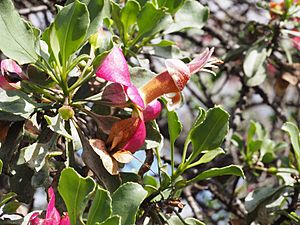Burra facts for kids
Quick facts for kids Burra |
|
|---|---|
 |
|
| Eremophila fraseri fraseri leaves and flowers | |
| Scientific classification | |
| Genus: |
Eremophila (plant)
|
| Species: |
fraseri
|
| Synonyms | |
Eremophila fraseri, also called burra or jilarnu, is a special flowering plant. It belongs to the figwort family. This plant is only found in Western Australia.
It can be a shrub or a small tree. Almost all parts of the plant, except the petals, are super sticky and shiny. This is because they are covered in a lot of resin, which is like a natural sap. Its flowers can be white, cream, pink, or brown.
Contents
What Does Burra Look Like?
Eremophila fraseri is a plant that stands upright. It usually grows to be about 1 to 4 meters (3 to 13 feet) tall. Its branches, leaves, and flower stalks are smooth and hairless. They are also very sticky and shiny because of the thick resin.
The leaves come in different sizes and shapes. They can be shaped like a spear or an egg. Each leaf has a stalk that is usually 12 to 22 mm (0.5 to 0.9 inches) long. The leaf blade itself is mostly 25 to 45 mm (1 to 1.8 inches) long and 12 to 28 mm (0.5 to 1.1 inches) wide.
Burra Flowers
The flowers usually grow one by one where the leaves meet the stem. Each flower has a stalk that is 15 to 35 mm (0.6 to 1.4 inches) long. There are 5 reddish-purple sepals, which are like small leaves that protect the flower bud. These sepals are different in size and shape.
The largest sepal is 15 to 35 mm (0.6 to 1.4 inches) long and egg-shaped. The smallest ones are 10.5 to 24 mm (0.4 to 0.9 inches) long and are narrow or spear-shaped. The petals are mostly 20 to 35 mm (0.8 to 1.4 inches) long. They are joined at the bottom to form a tube.
The petal tube is brown. The tips of the petals are whitish to pale purple. They often have brown or purple spots. Both the inside and outside of the petal tube are hairy. The petal tips on the sides bend back over the tube. The 4 stamens, which hold the pollen, stick out past the end of the petal tube.
Burra plants flower from March to November. After flowering, they produce dry, sticky, oval-shaped fruits. These fruits have a pointed end and are 9 to 13 mm (0.4 to 0.5 inches) long.
How Burra Got Its Name
The Eremophila fraseri plant was first officially described in 1881. This was done by a scientist named Ferdinand von Mueller. He published his description in a book called Fragmenta phytographiae Australiae.
The second part of the plant's scientific name, fraseri, honors Sir Malcolm Fraser. He was the Surveyor-General of Western Australia from 1872 to 1883.
Burra Subspecies
In 2007, another scientist named Robert Chinnock described two types, or subspecies, of Eremophila fraseri. These names are now accepted by plant experts.
- Eremophila fraseri subsp. fraseri: This type has egg-shaped leaves. These leaves are usually wider than 14 mm (0.6 inches).
- Eremophila fraseri subsp. parva: This type has oblong or oval leaves. These leaves are usually narrower than 12 mm (0.5 inches).
Where Burra Grows
The Eremophila fraseri subspecies fraseri grows in many different places. It can be found in various soil types. You can see it between the Hamersley Range and Gascoyne Junction. This area includes several regions in Western Australia, like Carnarvon, Gascoyne, Murchison, Pilbara, and Yalgoo.
The subspecies parva grows in scattered spots. It is found in the Meekatharra and Gascoyne regions. It usually grows in stony or sandy clay soil.
How People Use Burra
Traditional Uses
The burra plant is used by Indigenous people as a traditional medicine. They prepare the leaves to make a liquid. This liquid is then used on the skin to help with skin problems.
In the Yindjibarndi and Ngarluma languages, this plant is called Jilarnu. People often collect it from a place known as Millstream.
Growing Burra in Gardens
Even though many Eremophila plants are great for gardens, burra is not always the best choice. It can become woody over time. Sometimes, it also gets covered in a black, mold-like growth called sooty mould.
It can be tricky to grow new burra plants. It's usually done by taking cuttings from an existing plant. Burra likes soil that drains well and prefers full sun or some shade. It can handle dry conditions and can survive a little bit of frost.
Images for kids
-
E. fraseri fraseri growing south-west of the Kennedy Range National Park
-
E. fraseri parva growing near Gascoyne Junction




